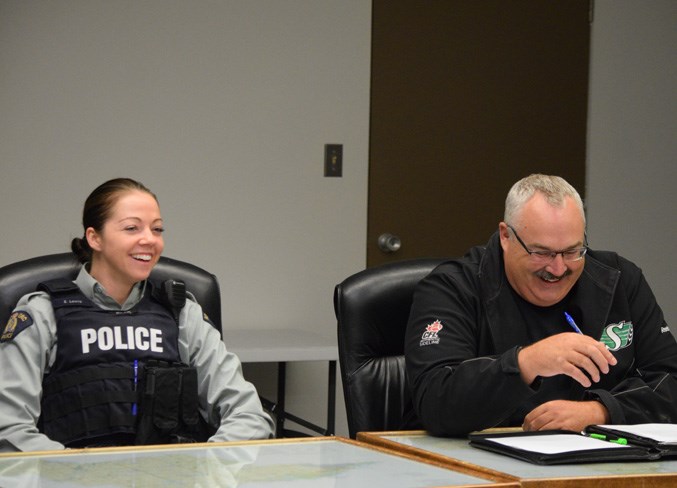Crime continues to be on a downward trend.
That is what RCMP Sgt. Bob Dodds told County of Barrhead councillors during their Oct. 2 meeting, making this the second straight quarter in which the overall crime rate has decreased.
“Our ‘person’ crimes at the detachment as a whole and in the county are the lowest they’ve been in a long time,” he said, noting that ‘person crimes’ are offences such as robbery, assault, kidnapping, extortion, criminal harassment, uttering threats and various sexual offences.
In the first eight months of 2018, total person crimes for the detachment area was 104, with the most frequent crime being assaults at 42.
From 2014 to 2017, the total number of person crimes rose from 121 to 148 and 152.
The total number of criminal files (all types of crime, in other words) for the detachment this year is 702, the second-lowest in five years.
The lowest number of criminal files was experienced in 2014, with 621 crimes reported.
“What this says to me — and this has been my mantra all along — is that we live in a safe area. Even with the increase in property crimes that we have seen, it has always remained a very safe community to live in as far as your personal, physical safety,” he said.
Dodds couldn’t explain what the reason is for the downward trend, saying it is much easier to determine an increase in crime.
“Sometimes when we are able to arrest some of the big offenders in the area and they are not out in the public committing crimes, we can point to that, but we know some of those people are still out there, so I’m at a loss.”
Another statistic that decreased over last year is motor vehicle collisions, which dropped from 280 in 2017 to 245 with no fatalities and only 12 injuries reported.
Unfortunately, it wasn’t all good news, as break-and-enters jumped to 79 from 40 the year before, the highest in five years.
“That does concern me, breaking into your house, shop, or business, is more aggressive than stealing your gas can, it is more personal,” he said.
Dodds said he suspects the reason for the increase is that the additional break-ins are being done by someone who has moved into the area.
“If we can catch that one person, we can solve 20 B&Es, but until we catch that person, the trend will continue.”
The other crime that increased was the possession of stolen property, which is at 36, the highest it has been in the last five years.
Despite the overall decrease in crimes, the community’s overall crime severity index increased slightly to 95.4, an increase of 1.6 per cent from 2016. The provincial average is 101.1.
The index measures not only how often a crime is committed, but also the severity of that crime.
“What drove our increase was the number of break-and-enters. They don’t just don’t take into account person offences,” Dodds said.
“While it is going up, it is going up at a rate that is lower than the provincial average and our overall score is well below the average. This is a safe community.”
On the issue of staffing, Dodds said they are still looking for someone to take the vacant school resource officer (SRO) position to work at Barrhead and area schools.
The previous SRO, Const. Robert Hynes, accepted a transfer to become a training officer at the RCMP’s training facility.
“We had someone lined up, but they were promoted to corporal. We do have someone in Saskatchewan who is interested. That means the two divisions, Alberta and Saskatchewan, have to start working some deals,” he said.
Coun. Ron Kleinfeldt asked if Dodds foresaw any difficulties with the upcoming Oct. 17 legalization of marijuana.
“The short answer is I don’t know, but it will probably change the ways we do things,” Dodds said.
He added while the Canadian Justice Department has approved a roadside device to test for cannabis use in impaired drivers — the Dräger DrugTest® 5000, which tests for alcohol, cocaine and THC, the psychotropic compound in marijuana — there is still a long way to go before the devices make their way to local law enforcement.
“It isn’t being accepted by a lot of municipal police departments,” Dodds noted, referencing concerns raised in recent weeks about the accuracy of the device’s results.
“We know that the first stop is going to end up in the Supreme Court of Canada,” Dodds said. “That process will take years and that, in the end, will determine if the device is used.”
He added that just because cannabis has been legalized, it doesn’t mean illicit use of cannabis is going to stop.
“They [provincial government] are going to create ticket-able offences, and if people start disputing those, you are going to see a major glut in the court system,” Dodds said.
“But in the end, I’m not sure it is going to change a whole lot. As we speak there are people who are driving out there that are high, the same as driving while drunk and we are working on catching them.”


.jpg;w=120;h=80;mode=crop)
